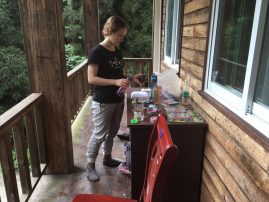Important Plant Research in Sichuan
July 2017
By Ramana Callan and Loreena Avery
As the Sichuan summer rolls in, we have a short window of opportunity to survey the plant diversity at the nature reserves where we may soon release our panda cubs. Although the mosquitos have emerged en masse and the rain falls heavily every afternoon, plants that we could not identify last season are in flower and new vegetation springs forth from the cool mountain soil.
Over the past month, Loreena (our summer intern) and I have spent several days at a field research station high in the Minshan Mountains. The station is only accessible by a steep and rugged dirt road that switchbacks up the mountain side and leaves me feeling car sick. The road is pitted and partially destroyed by a severe flooding event that occurred several years ago (when our reintroduction project was just a dream that Global Cause and the Chengdu Research Base shared). However, once we reach our destination, high above the clouds, we can enjoy the luxury of warm beds and hot running water. Best of all is the endless supply of green tea and excellent home-cooked meals prepared by a local woman who taught us the Chinese words for ginger and garlic.
We only have a few weeks left to resurvey the vegetation plots I completed with Georgia and Sarah last November and to survey twenty new plots to ensure that we have a sufficient sample size for our “pre-treatment data”. In this case, the “treatment” is introducing one of our pandas to the transitional enclosure and documenting any changes to the bamboo density and understory plant community.
Hopefully, the pandas will eat the bamboo in our plots; otherwise it will be impossible to document any changes! This is why we need so many plots, to increase the likelihood that the pandas forage on the bamboo in at least some of them. To have “before, after and control data” is the gold standard for experimental design. Our reintroduction project provides us with the perfect chance to conduct a unique field experiment that would not be possible otherwise.
Since we want to study the impact of giant pandas on the existing vegetation, it is important that we sample the soil in which these plants grow. This allows us to control for confounding factors and also to document potential effects of panda feces on soil chemistry. At each of our plots, we measure the soil’s pH, nitrogen, phosphorous, and potassium content.
At the reserve, Loreena and I collect soil samples from the bamboo forests in the mornings and spend the long rainy afternoons processing the samples on our scenic balcony. To our surprise, the soil is very acidic, with no nitrogen detected. Loreena was very intrigued by these results and had the idea to measure the pH of our “distilled” water which turned out not to be neutral. We are looking into sourcing our distilled water from a local University instead of the local superstore!
We also use a soil probe which allows us to measure the soil’s moisture and light infiltration. The light levels are very low at each location, which undoubtedly causes the low biodiversity in the understory. Since the soil composition varies from sandy to loamy-clay, water penetration also varies between plots.
During our last visit to the nature reserve, we brought Dr. Tan Jinbo and his assistant from Sichuan University to help us identify the local plants. While we expected to be out for the whole day, Dr. Tan was able to identify all of our unknown species within one hour of walking through the bamboo forest. He had a key to the local plants on his laptop and was able to translate the Chinese names to genus and species names almost instantly. His guidance has been crucial to our efforts.
Since we had a few hours to spare on our last visit, we spent the rest of the afternoon helping Elizabeth McHone, a fourth-year PhD student at Drexel University, to search for milkweed plants for her dissertation research. Elizabeth came to visit us in Dujiangyan in search of the Chrysochus beetle, typically found on milkweed plants. Unfortunately, even with Dr. Tan’s fervent help, she never found any milkweed plants in Sichuan let alone sign of her elusive beetle. However, a few days later, we received happy news from Hefei in Anhui Province: Elizabeth was finally successful. Dr. Tan, Loreena and I were so happy to receive images of her beautiful metallic beetle on WeChat!
There is a great amount of work that still needs to be done at the nature reserves, both inside and outside the transitional enclosures. In a few weeks’ time, we hope to see see the influence a large subadult giant panda has on the bamboo density, light infiltration and soil chemistry of the microhabitat. However, it may take several years of revisiting these plots to document the long term effects on the plant community (i.e. species composition, richness and relative abundance).
Global Cause is dedicated to continuing this research and training new scientists in the collection and analysis of the data. It’s great to be contributing to its Wild Panda Team!






Leave a Reply
You must be logged in to post a comment.